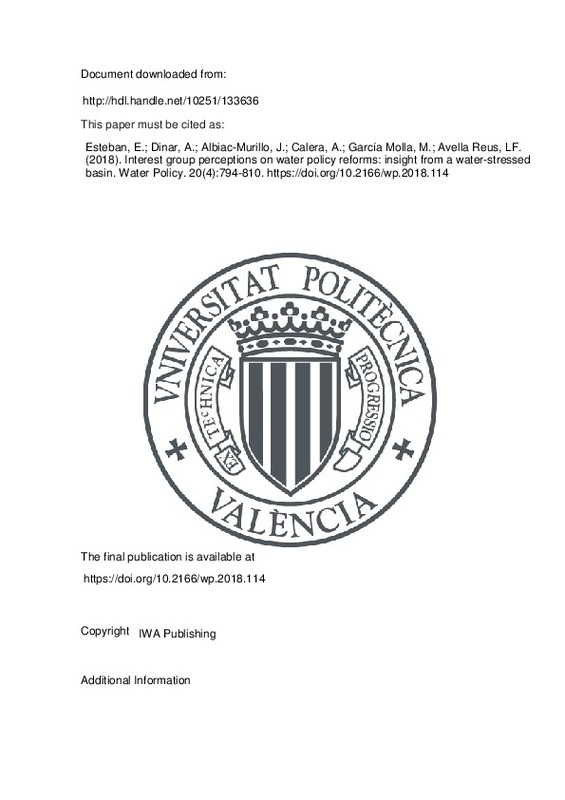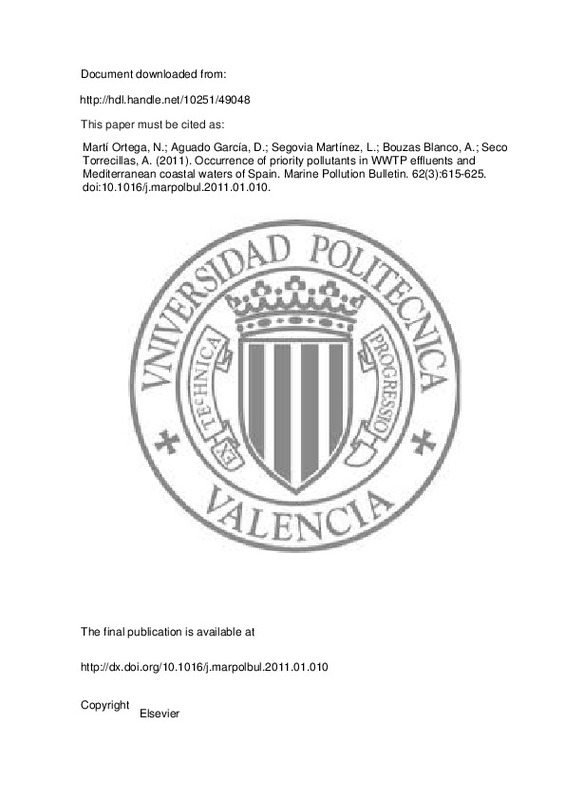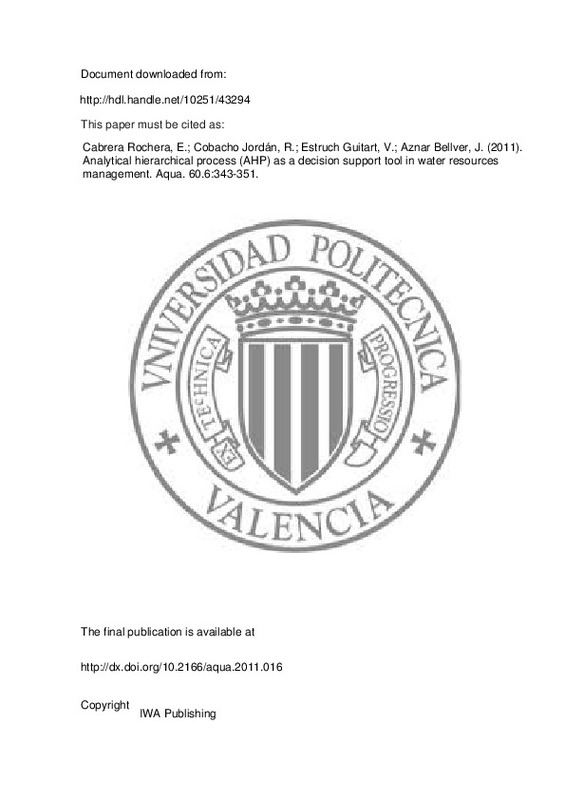JavaScript is disabled for your browser. Some features of this site may not work without it.
Buscar en RiuNet
Listar
Mi cuenta
Estadísticas
Ayuda RiuNet
Admin. UPV
Interest group perceptions on water policy reforms: insight from a water-stressed basin
Mostrar el registro sencillo del ítem
Ficheros en el ítem
| dc.contributor.author | Esteban, Encarna
|
es_ES |
| dc.contributor.author | Dinar, Ariel
|
es_ES |
| dc.contributor.author | Albiac-Murillo, José
|
es_ES |
| dc.contributor.author | Calera, Alfonso
|
es_ES |
| dc.contributor.author | García Molla, Marta
|
es_ES |
| dc.contributor.author | Avella Reus, Lorenzo Federico
|
es_ES |
| dc.date.accessioned | 2019-12-25T21:01:56Z | |
| dc.date.available | 2019-12-25T21:01:56Z | |
| dc.date.issued | 2018 | es_ES |
| dc.identifier.issn | 1366-7017 | es_ES |
| dc.identifier.uri | http://hdl.handle.net/10251/133636 | |
| dc.description.abstract | [EN] Water policies have been implemented worldwide to face water stress. However, the existence of water users' groups with opposite interests and different political power results in the plain failure or low effectiveness of water policy reforms. A better understanding of users' perceptions regarding policy outcomes is important to avoid the failure of water policies and the intensification of water conflicts. This paper empirically examines the divergent perception of interest groups on the implementation of different policies dealing with water scarcity and their proactive involvement with water agencies. We have conducted a survey in the Jucar River Basin (a water-stressed basin in southeastern Spain) to analyze interest group opinions regarding water policy effectiveness and water institutions' performance in water management. Questionnaires were sent to the main irrigation districts and urban water utilities within the basin. The collected information gives a general picture of the behavior of opposite water interest groups in this basin. The analysis of the perceptions on water policy reform between the groups highlights the existence of significant differences between preferred measures to address water scarcity and lobbying capacity. These differences depend on the size of the group, the specific basin location, and other group characteristics. | es_ES |
| dc.language | Inglés | es_ES |
| dc.publisher | IWA Publishing | es_ES |
| dc.relation.ispartof | Water Policy | es_ES |
| dc.rights | Reserva de todos los derechos | es_ES |
| dc.subject | Interest groups | es_ES |
| dc.subject | Irrigators | es_ES |
| dc.subject | Stakeholders' behavior | es_ES |
| dc.subject | Survey | es_ES |
| dc.subject | Urban water utilities | es_ES |
| dc.subject | Water policy reforms | es_ES |
| dc.subject | Water scarcity | es_ES |
| dc.subject.classification | ECONOMIA, SOCIOLOGIA Y POLITICA AGRARIA | es_ES |
| dc.title | Interest group perceptions on water policy reforms: insight from a water-stressed basin | es_ES |
| dc.type | Artículo | es_ES |
| dc.identifier.doi | 10.2166/wp.2018.114 | es_ES |
| dc.rights.accessRights | Abierto | es_ES |
| dc.contributor.affiliation | Universitat Politècnica de València. Departamento de Economía y Ciencias Sociales - Departament d'Economia i Ciències Socials | es_ES |
| dc.description.bibliographicCitation | Esteban, E.; Dinar, A.; Albiac-Murillo, J.; Calera, A.; García Molla, M.; Avella Reus, LF. (2018). Interest group perceptions on water policy reforms: insight from a water-stressed basin. Water Policy. 20(4):794-810. https://doi.org/10.2166/wp.2018.114 | es_ES |
| dc.description.accrualMethod | S | es_ES |
| dc.relation.publisherversion | https://doi.org/10.2166/wp.2018.114 | es_ES |
| dc.description.upvformatpinicio | 794 | es_ES |
| dc.description.upvformatpfin | 810 | es_ES |
| dc.type.version | info:eu-repo/semantics/publishedVersion | es_ES |
| dc.description.volume | 20 | es_ES |
| dc.description.issue | 4 | es_ES |
| dc.relation.pasarela | S\368646 | es_ES |
| dc.description.references | Böhmelt, T., Bernauer, T., Buhaug, H., Gleditsch, N. P., Tribaldos, T., & Wischnath, G. (2014). Demand, supply, and restraint: Determinants of domestic water conflict and cooperation. Global Environmental Change, 29, 337-348. doi:10.1016/j.gloenvcha.2013.11.018 | es_ES |
| dc.description.references | Devlin, C., & Hendrix, C. S. (2014). Trends and triggers redux: Climate change, rainfall, and interstate conflict. Political Geography, 43, 27-39. doi:10.1016/j.polgeo.2014.07.001 | es_ES |
| dc.description.references | Estrela T. , (2004). Jucar Pilot River Basin: Provisional Article 5 Report. Oficina de Planificación Hidrográfica. Confederación Hidrográfica del Júcar. Ministerio de Medio Ambiente, Valencia, Spain. | es_ES |
| dc.description.references | Gandure, S., Walker, S., & Botha, J. J. (2013). Farmers’ perceptions of adaptation to climate change and water stress in a South African rural community. Environmental Development, 5, 39-53. doi:10.1016/j.envdev.2012.11.004 | es_ES |
| dc.description.references | Gizelis, T.-I., & Wooden, A. E. (2010). Water resources, institutions, & intrastate conflict. Political Geography, 29(8), 444-453. doi:10.1016/j.polgeo.2010.10.005 | es_ES |
| dc.description.references | Greiner, R., & Gregg, D. (2011). Farmers’ intrinsic motivations, barriers to the adoption of conservation practices and effectiveness of policy instruments: Empirical evidence from northern Australia. Land Use Policy, 28(1), 257-265. doi:10.1016/j.landusepol.2010.06.006 | es_ES |
| dc.description.references | Greiner, R., Patterson, L., & Miller, O. (2009). Motivations, risk perceptions and adoption of conservation practices by farmers. Agricultural Systems, 99(2-3), 86-104. doi:10.1016/j.agsy.2008.10.003 | es_ES |
| dc.description.references | Hendrix, C. S., & Glaser, S. M. (2007). Trends and triggers: Climate, climate change and civil conflict in Sub-Saharan Africa. Political Geography, 26(6), 695-715. doi:10.1016/j.polgeo.2007.06.006 | es_ES |
| dc.description.references | Kahil, M. T., Ward, F. A., Albiac, J., Eggleston, J., & Sanz, D. (2016). Hydro-economic modeling with aquifer–river interactions to guide sustainable basin management. Journal of Hydrology, 539, 510-524. doi:10.1016/j.jhydrol.2016.05.057 | es_ES |
| dc.description.references | Mekonnen, M. M., & Hoekstra, A. Y. (2016). Four billion people facing severe water scarcity. Science Advances, 2(2), e1500323. doi:10.1126/sciadv.1500323 | es_ES |
| dc.description.references | Mertz, O., Mbow, C., Reenberg, A., & Diouf, A. (2008). Farmers’ Perceptions of Climate Change and Agricultural Adaptation Strategies in Rural Sahel. Environmental Management, 43(5), 804-816. doi:10.1007/s00267-008-9197-0 | es_ES |
| dc.description.references | Ortega-Reig, M., Palau-Salvador, G., Cascant i Sempere, M. J., Benitez-Buelga, J., Badiella, D., & Trawick, P. (2014). The integrated use of surface, ground and recycled waste water in adapting to drought in the traditional irrigation system of Valencia. Agricultural Water Management, 133, 55-64. doi:10.1016/j.agwat.2013.11.004 | es_ES |
| dc.description.references | Pérez-Martín, M. A., Estrela, T., Andreu, J., & Ferrer, J. (2014). Modeling Water Resources and River-Aquifer Interaction in the Júcar River Basin, Spain. Water Resources Management, 28(12), 4337-4358. doi:10.1007/s11269-014-0755-3 | es_ES |
| dc.description.references | Raleigh, C., & Urdal, H. (2007). Climate change, environmental degradation and armed conflict. Political Geography, 26(6), 674-694. doi:10.1016/j.polgeo.2007.06.005 | es_ES |
| dc.description.references | Sanz, D., Gómez-Alday, J. J., Castaño, S., Moratalla, A., De las Heras, J., & Martínez-Alfaro, P. E. (2009). Hydrostratigraphic framework and hydrogeological behaviour of the Mancha Oriental System (SE Spain). Hydrogeology Journal, 17(6), 1375-1391. doi:10.1007/s10040-009-0446-y | es_ES |
| dc.description.references | Urquijo, J., & De Stefano, L. (2015). Perception of Drought and Local Responses by Farmers: A Perspective from the Jucar River Basin, Spain. Water Resources Management, 30(2), 577-591. doi:10.1007/s11269-015-1178-5 | es_ES |
| dc.description.references | Van Oel, P. R., Krol, M. S., & Hoekstra, A. Y. (2009). A river basin as a common‐pool resource: A case study for the Jaguaribe basin in the semi‐arid Northeast of Brazil. International Journal of River Basin Management, 7(4), 345-353. doi:10.1080/15715124.2009.9635393 | es_ES |
| dc.description.references | Ward, F. A., & Pulido-Velazquez, M. (2008). Water conservation in irrigation can increase water use. Proceedings of the National Academy of Sciences, 105(47), 18215-18220. doi:10.1073/pnas.0805554105 | es_ES |







![[Cerrado]](/themes/UPV/images/candado.png)



